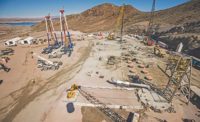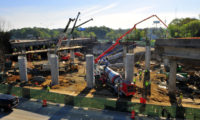The 2005-2007 drought that parched the Southeast wasn’t the worst Atlanta has endured since its establishment as a railroad hub in the 1830s. But with a burgeoning population dependent on a single water supply source—the Chattahoochee River, fed by Lake Lanier—that itself had been crippled by prolonged dry conditions, the drought was bad enough to spur action.
“Nobody wanted to go through that level of drought again without better preparedness,” recalls Ade Abon, Atlanta’s senior watershed director.
Memories of the dry spell were fresh enough in March 2016 to get voters to overwhelmingly approve directing revenue from a municipal option sales tax to a $1-billion, five-year infrastructure improvement program, the centerpiece of which is a nearly complete $300-million water supply tunnel system that will turn the former Bellwood Quarry into a 2.4-billion-gallon reservoir. Together, the reservoir and tunnel are expanding Atlanta’s emergency raw water reserves from the current three days to as much as three months.
Abon explains that while the city’s 2006 purchase of the quarry was made with the idea of creating a reservoir, the drought’s far-reaching consequences made going bigger a better idea. Rather than simply build a conventional five-mile pipeline connection to the river, a 10-ft-dia tunnel “allows us to take full advantage of the quarry’s depth without the ground surface disruption associated with pipeline construction,” he says.
And with Atlanta-area population projected to nearly double over the next decade, maximizing reservoir capacity also offered long-term resiliency.
“The tunnel system will be good for another 100 years,” Abon says.
Atlanta had both concept and funding to undertake its water supply program. What it lacked was time.
Cognizant that any given stretch of sunny days could herald the onset of another drought, an aggressive design and construction schedule was a must, despite uncertainties inherent with conducting an extensive construction effort more than 500 ft below the surface in some areas. The strategy also required concurrent work at multiple sites, including drilling access shafts, constructing new pump stations and integrating the tunnel with Atlanta’s existing municipal water treatment infrastructure, which would also undergo upgrades.
Having assessed multiple approaches, Atlanta determined that construction manager at-risk project delivery would be the best way to launch and sustain a three-year construction effort in mid-2016, led by a joint venture of Burlington, Vt.-based PC Construction Co. and H.J. Russell & Co. of Atlanta.
Getting started might well have been the project’s most difficult part, however. Don Del Nero, vice president of Stantec, the tunnel’s lead designer, explains that when guaranteed maximum prices (GMPs) offered by subcontractors were higher than expected, the city asked for the partial design specifications to be brought up to 100%.
Stantec responded, Del Nero says, by accelerating design work with a beefed-up staff while geotechnical surveys got underway and arrangements were made to build a 400-ft-long, 12.5-ft-dia tunnel boring machine, later to be named Driller Mike. The resulting reduction in uncertainty, plus requiring subcontractors to address numerous contingency requirements, Del Nero adds, “made the GMPs more reasonable and brought risks to an acceptable level.”
It also enabled the project team to finally take advantage of CMAR time-saving benefits as full-scale construction ramped up. Had the city of Atlanta opted for a more conventional project delivery approach, says PC Construction project director Bob Huie, “We might still have one or two years to go.”
A Race to the River
Instead, the multifaceted water supply program appears on track for completion by the end of 2019. Last October, Driller Mike completed its two-year, five-mile journey from the 550-ft-deep quarry bottom to the Hemphill and Chattahoochee water treatment plants, which together process 75% of Atlanta’s drinking water.
Built by the Robbins Co., Solon, Ohio, and owned and operated by tunneling subcontractor Guy F. Atkinson Construction—which teamed with Technique Concrete Construction for the project—Driller Mike used sophisticated guidance technology to arrive within 2 in. of the specified target. Though the route through the gneiss bedrock presented a few complications, curves had to be carefully navigated via a series of short chords, according to Atkinson project manager Jake Coibion.
“TBMs don’t maneuver as easily as some people think,” Coibion says.
One area of particular concern during the tunneling phase was around the Hemphill water treatment plant, where Atlanta’s main water supply reservoir is located. Pre-excavation grouting safeguarded the reservoir as Driller Mike made its way underneath the area, setting the stage for blind-bore drilling of five 11-ft-dia shafts that facilitated construction of a drill-and-blast tunnel connection with the facility’s new pump station.
The blind-bore approach was intended to safeguard the facilities and minimize disruption to adjacent neighborhoods. Yet not long after drilling subcontractor North American Drilling began work, the developer of a nearby condominium project sued to halt the project, claiming that the shaft construction was having a negative effect on sales.
Other than making accommodations such as eliminating nighttime work on the shafts, the issue was soon resolved with no effect on the project’s critical path, Coibion says.
An unexpected obstacle to the otherwise good tunneling progress arose when Driller Mike unexpectedly encountered groundwater containing volatile organic compounds, later found to have originated from a nearby industrial area.
“We knew there was an industrial property above, but tests showed no indication that groundwater would be an issue,” Del Nero says. He adds that while the infiltration itself was minimal, the presence of the TBM’s variable frequency drive in a confined space where temperatures routinely reach 80-90 degrees posed a health hazard for Atkinson’s workers. A hazard analysis determined that work could continue, albeit at a slower pace than before.
“It took us three months to go a thousand feet,” says Coibion, adding that protective gear, respirators and other measures helped safeguard the TBM workers. Once safely clear of the infiltration zone, “we did the next 8,000 feet in two months,” he adds.
Abon says the infiltration was remediated with grout, and no recurrence has been found, though the area will continue to be closely monitored.
A final tunneling task is currently underway at the Chattahoochee treatment plant as an add-on to the original project. Atkinson is building a 2,000-ft-long drill-and-blast tunnel that will link the system to a new river water intake pump station, a facility that the city expects to award under a separate construction contract this summer.
Aiming for activation
Atkinson/Technique workers are currently installing 1-ft-thick, cast-in-place concrete lining panels and associated grouting along approximately 60% of the tunnel interior. Limited cracking in the remaining sections required no lining, Huie says.
Because supplying concrete for the liner from the surface would have required installing multiple dropholes along an active rail corridor, the mix is instead transported through the tunnel from a ready-mix batch plant located near the quarry.
Coibion says that because the mix may be as much as two hours old by the time it reaches its destination, “it was a big challenge to develop a mix that would retain its plasticity for that long, and be ready to be remixed, poured and set.”
Completion of the tunnel liner will coincide with the finishing touches on a new 200-million-gallon-a-day pump station at the quarry, and a new 135-mgd underground pump station at the Hemphill water treatment plant, a little more than a mile away. A 70-ton overhead bridge crane was required to install vertical turbine pumps and three submersible pumps 250 and 300 ft below the quarry pump station. The pumps will regulate water flow between the tunnel and reservoir via a system of adits, while a 40-ft-long, full-diameter concrete tunnel plug located between the tunnel’s riser and drop shafts isolates the system from the quarry.
Atlanta’s water supply program is providing the city with more than just a long-term drought defense solution. Ground was broken last fall for a $26.5-million, three-phase project to create a new park around the quarry. Beginning with construction of a distinctive gateway entrance, the park will rehabilitate existing access routes to an overlook that enjoys sweeping views of both the reservoir and the Atlanta skyline.
Though the reservoir is the project’s most visible element, Huie says the collaboration fostered by CMAR was by far its most valuable commodity.
“The process was hard at first,” he admits, “but it got easier as we went along.”











Post a comment to this article
Report Abusive Comment